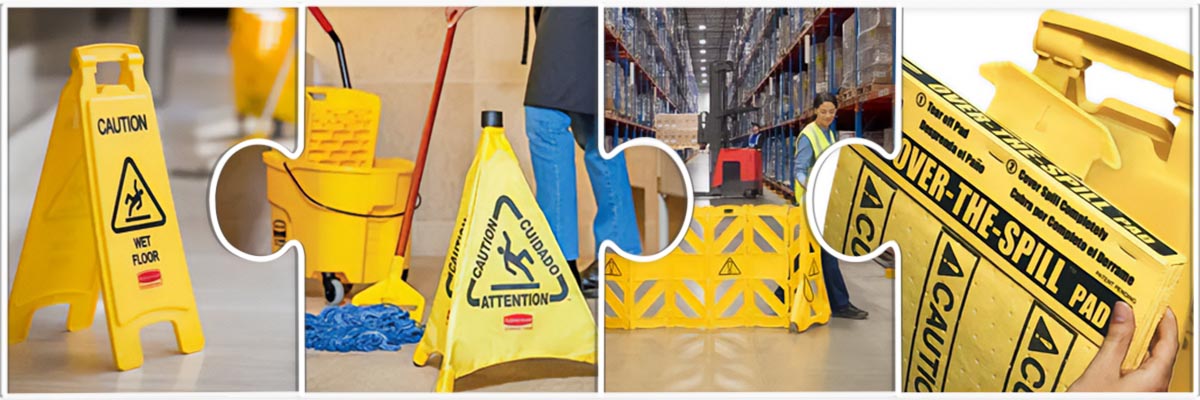Preventing Slips, Trips, and Falls in Your Facility
Slip-and-fall accidents are among the biggest liability risks for any facility. These incidents can lead to serious injuries, lost productivity, and costly claims. The best defense is a proactive plan, one that prepares your staff to respond quickly and effectively when spills and other hazards occur.

Slip, Trip, and Fall Risk Statistics
Each year, slips, trips, and falls cause millions of workplace injuries. Understanding the scope of the problem highlights why prevention must be a priority for every facility manager.
- There are an estimated two million employee falls each year.3
- 20% of all workplace injuries involving days away from work are due to slips, trips and falls.
- 30% of people who experience a slip and fall will suffer moderate to severe injuries.2
- Slips and falls are the leading cause of death in the workplace.1
- The average cost to an employer of a slip, trip, and fall incident is $40,000.5
- Slips, trips, and falls cost a total of $11 billion per year.6
Incident Prevention Standards
Regulatory bodies like OSHA establish standards and guidelines to help employers mitigate slip, trip, and fall risks.7 Following these best practices is critical to maintaining a safe and compliant environment:
- Warning Signs: Provide clear, visible warning signs for wet floor areas.
- Hazard Removal: Quickly absorb and remove hazards to prevent staff and patrons from slipping.
- Keep Floors Clean & Dry: Continually wet surfaces can harbor mold, fungi, and bacteria in addition to creating slip hazards.
- Clear Passageways: Keep exits and walkways free of obstruction at all times.
Implementing these practices helps minimize risk while demonstrating your facility’s commitment to safety.
Common Causes and High-Risk Areas
Slips, trips, and falls are a leading cause of workplace injury, but with proper tools and processes, the risks can be mitigated. The most common causes include human factors such as rushing, fatigue, or distraction; housekeeping issues like cluttered walkways; and unreported wet or slippery surfaces.
High-risk areas to monitor include:
- Entryways – Snow, rain, ice, or door lips can make these areas slick.
- Dining Areas – Spilled beverages and food can create hazards near tables or drink stations.
- Restrooms – Water near sinks or toilets and debris on the floor increase risk.
- Kitchens – Grease, oil, and sink spillage are common slip hazards.

Best-In-Class Spill Removal Process
Establishing a clear process ensures a fast and effective response to spills.
- Contain: Place warning signs and safety cones in a highly visible location.
- Absorb: Use absorbent pads or spill mops to quickly soak up the liquid.
- Dispose: Discard used absorbent materials in an appropriate waste container.
- Clean: Mop the area to remove residue, then wring the mop dry and store tools properly.
By following this process, facilities can reduce the risk of injury and maintain a clean, professional environment.
Recommended Products
A complete slip, trip, and fall prevention plan includes the right safety tools. These Rubbermaid Commercial products are designed for efficiency, visibility, and compliance.
- Mobile Barrier, 13 Feet, Yellow (FG9S1100YEL) – Lightweight and compact when closed has a 2’ to 13” footprint, but extends out to 13’ fully opened. Articulating safety barrier with 16 panels that can form straight, curved, or circular configurations. Easy to move, store, and highly visible.
- Over The Spill® Pads Tablet, Yellow (FG425400YEL) – Contains 22 absorbent pads that resist slipping and soak up water or oil quickly, soaking up to 14 oz per pad. Pads prevent slipping while the universal caution symbol and “Caution Wet Floor” message in English and Spanish alert pedestrians. Tablet can be hung on (FG611277YEL) or mounted on the wall.
- Multilingual “Wet Floor” Pop-Up Floor Cone, 20", Yellow (FG9S0000YEL) – A collapsible, automatically deploying cone when removed from wall-mounted storage tube with “Caution” warnings in English, French, and Spanish for effective communication.
Each product has ANSI/OSHA-compliant colors and symbols, as applicable, and is engineered to enhance safety visibility in busy indoor environments.
Let Hillyard Help You Plan
Hillyard has cleaning and safety experts across the United States who can help your team build world-class cleaning and safety processes. Use the "I'm Interested" form below, and one of our representatives will contact you to discuss how to strengthen your facility’s slip, trip, and fall prevention program.
Frequently Asked Questions
Q1: What’s the most important step in preventing slips and falls?
The key is preparation. Having the right tools, like warning signs, absorbent pads, and mobile barriers, ensures your team can respond immediately when hazards appear.
Q2: Are multilingual warning signs really necessary?
Yes. Facilities often have diverse staff and visitors. Multilingual cones ensure everyone understands the hazard regardless of language barriers.
Q3: How often should safety signage and equipment be inspected?
Inspect safety products regularly to ensure visibility, cleanliness, and structural integrity. Replace damaged or illegible signage immediately. Start with monthly inspections and adjust the frequency based on the results.
References
1. National Safety Council (NSC)
2. Centers for Disease Control and Prevention (CDC)
3. National Safety Council (NSC)
4. Bureau of Labor Statistics (BLS)
5. Centers for Disease Control and Prevention (CDC)
6. Business and Industry Connection
7. OSHA [1910.145(c)(2)] - Accident Prevention Signs and Tags Standard